Business Analysis: Tesco's Pestle and Change Management Strategies
VerifiedAdded on 2022/12/23
|7
|1713
|67
Report
AI Summary
This report provides a comprehensive analysis of Tesco's business environment, focusing on the application of Pestle analysis to understand the macro factors influencing the company, including political, economic, social, technological, legal, and environmental aspects. It examines how these factors drive change within the organization. The report further explores Tesco's use of Kotter's eight-step change management model to implement new initiatives, improve technology, and adapt to market dynamics. It details each step of the change management process, from creating urgency and forming a powerful coalition to anchoring changes and reviewing performance. The analysis highlights Tesco's strategies for adapting to changing consumer preferences, technological advancements, and legal and environmental regulations. The report concludes by emphasizing the importance of understanding and responding to both micro and macro environmental factors for organizational success and includes a detailed references section.
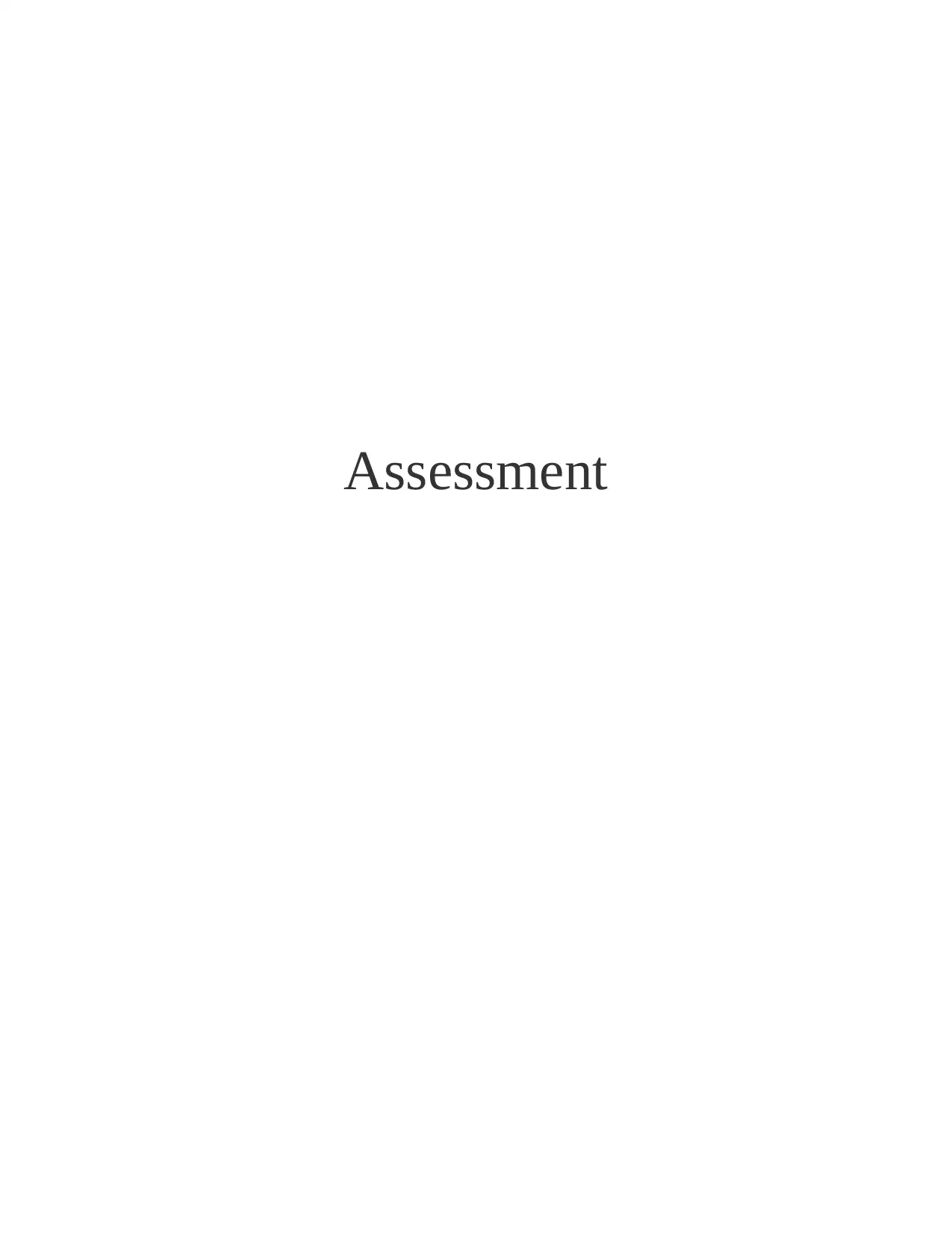
Assessment
Paraphrase This Document
Need a fresh take? Get an instant paraphrase of this document with our AI Paraphraser
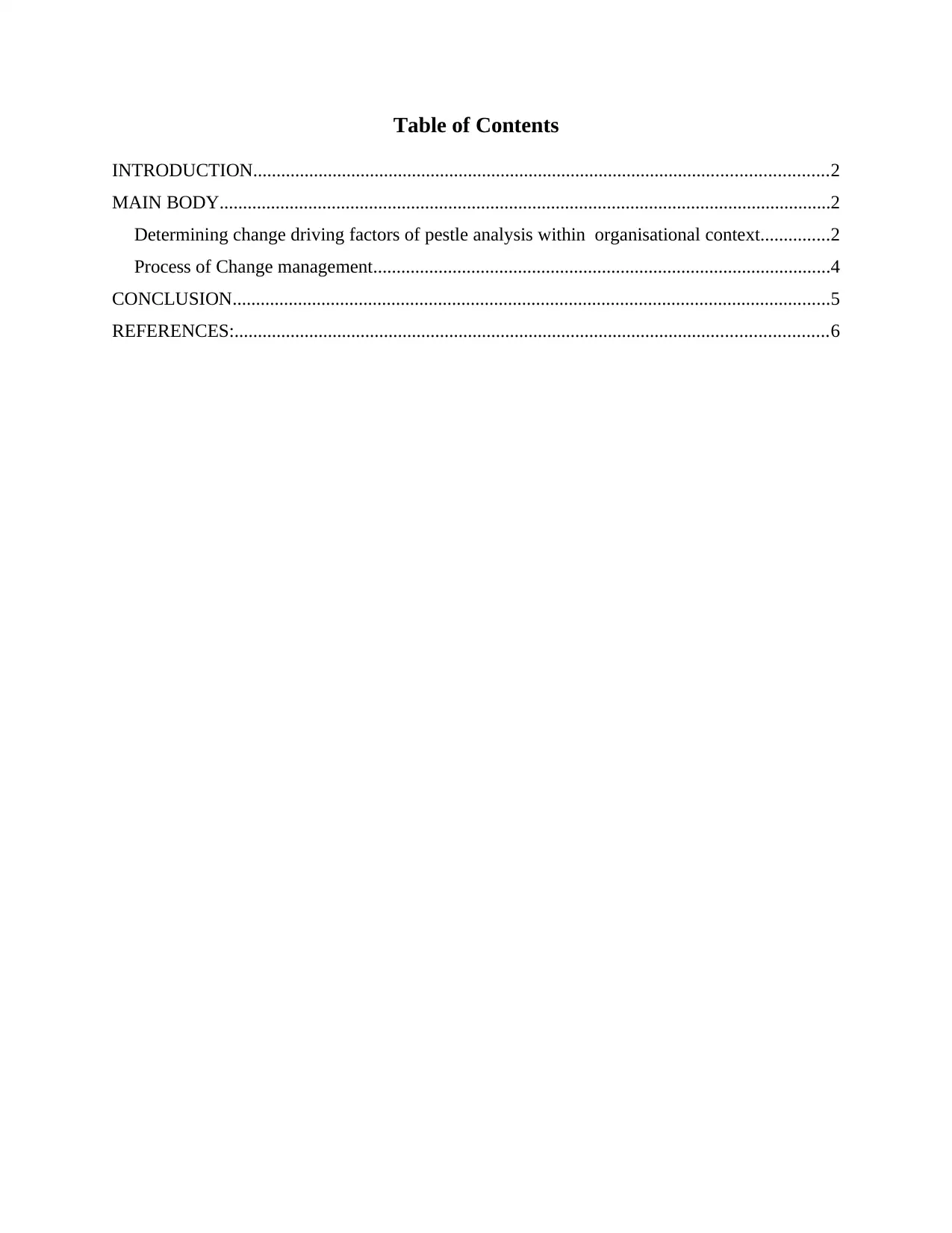
Table of Contents
INTRODUCTION...........................................................................................................................2
MAIN BODY...................................................................................................................................2
Determining change driving factors of pestle analysis within organisational context...............2
Process of Change management..................................................................................................4
CONCLUSION................................................................................................................................5
REFERENCES:...............................................................................................................................6
INTRODUCTION...........................................................................................................................2
MAIN BODY...................................................................................................................................2
Determining change driving factors of pestle analysis within organisational context...............2
Process of Change management..................................................................................................4
CONCLUSION................................................................................................................................5
REFERENCES:...............................................................................................................................6
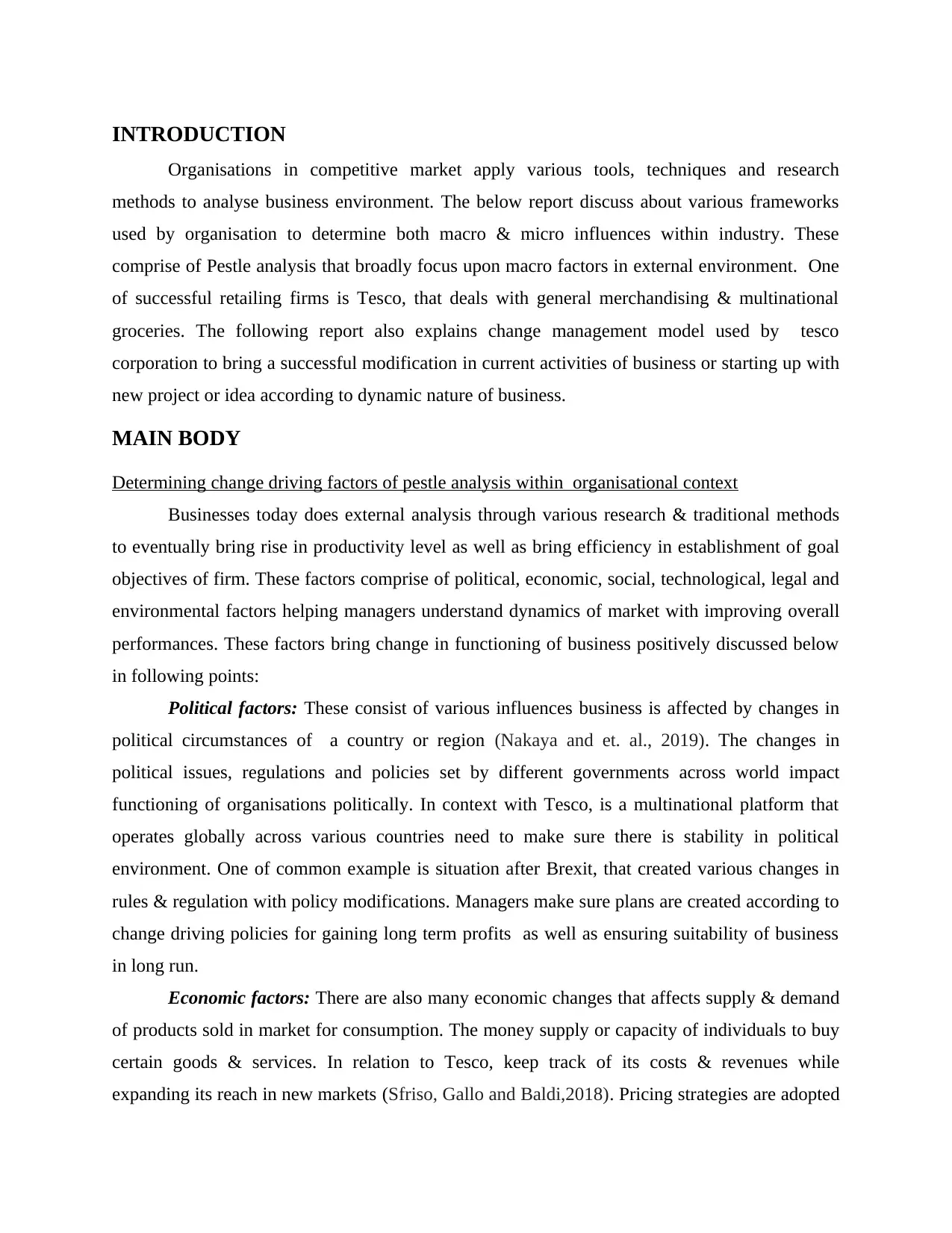
INTRODUCTION
Organisations in competitive market apply various tools, techniques and research
methods to analyse business environment. The below report discuss about various frameworks
used by organisation to determine both macro & micro influences within industry. These
comprise of Pestle analysis that broadly focus upon macro factors in external environment. One
of successful retailing firms is Tesco, that deals with general merchandising & multinational
groceries. The following report also explains change management model used by tesco
corporation to bring a successful modification in current activities of business or starting up with
new project or idea according to dynamic nature of business.
MAIN BODY
Determining change driving factors of pestle analysis within organisational context
Businesses today does external analysis through various research & traditional methods
to eventually bring rise in productivity level as well as bring efficiency in establishment of goal
objectives of firm. These factors comprise of political, economic, social, technological, legal and
environmental factors helping managers understand dynamics of market with improving overall
performances. These factors bring change in functioning of business positively discussed below
in following points:
Political factors: These consist of various influences business is affected by changes in
political circumstances of a country or region (Nakaya and et. al., 2019). The changes in
political issues, regulations and policies set by different governments across world impact
functioning of organisations politically. In context with Tesco, is a multinational platform that
operates globally across various countries need to make sure there is stability in political
environment. One of common example is situation after Brexit, that created various changes in
rules & regulation with policy modifications. Managers make sure plans are created according to
change driving policies for gaining long term profits as well as ensuring suitability of business
in long run.
Economic factors: There are also many economic changes that affects supply & demand
of products sold in market for consumption. The money supply or capacity of individuals to buy
certain goods & services. In relation to Tesco, keep track of its costs & revenues while
expanding its reach in new markets (Sfriso, Gallo and Baldi,2018). Pricing strategies are adopted
Organisations in competitive market apply various tools, techniques and research
methods to analyse business environment. The below report discuss about various frameworks
used by organisation to determine both macro & micro influences within industry. These
comprise of Pestle analysis that broadly focus upon macro factors in external environment. One
of successful retailing firms is Tesco, that deals with general merchandising & multinational
groceries. The following report also explains change management model used by tesco
corporation to bring a successful modification in current activities of business or starting up with
new project or idea according to dynamic nature of business.
MAIN BODY
Determining change driving factors of pestle analysis within organisational context
Businesses today does external analysis through various research & traditional methods
to eventually bring rise in productivity level as well as bring efficiency in establishment of goal
objectives of firm. These factors comprise of political, economic, social, technological, legal and
environmental factors helping managers understand dynamics of market with improving overall
performances. These factors bring change in functioning of business positively discussed below
in following points:
Political factors: These consist of various influences business is affected by changes in
political circumstances of a country or region (Nakaya and et. al., 2019). The changes in
political issues, regulations and policies set by different governments across world impact
functioning of organisations politically. In context with Tesco, is a multinational platform that
operates globally across various countries need to make sure there is stability in political
environment. One of common example is situation after Brexit, that created various changes in
rules & regulation with policy modifications. Managers make sure plans are created according to
change driving policies for gaining long term profits as well as ensuring suitability of business
in long run.
Economic factors: There are also many economic changes that affects supply & demand
of products sold in market for consumption. The money supply or capacity of individuals to buy
certain goods & services. In relation to Tesco, keep track of its costs & revenues while
expanding its reach in new markets (Sfriso, Gallo and Baldi,2018). Pricing strategies are adopted
⊘ This is a preview!⊘
Do you want full access?
Subscribe today to unlock all pages.

Trusted by 1+ million students worldwide
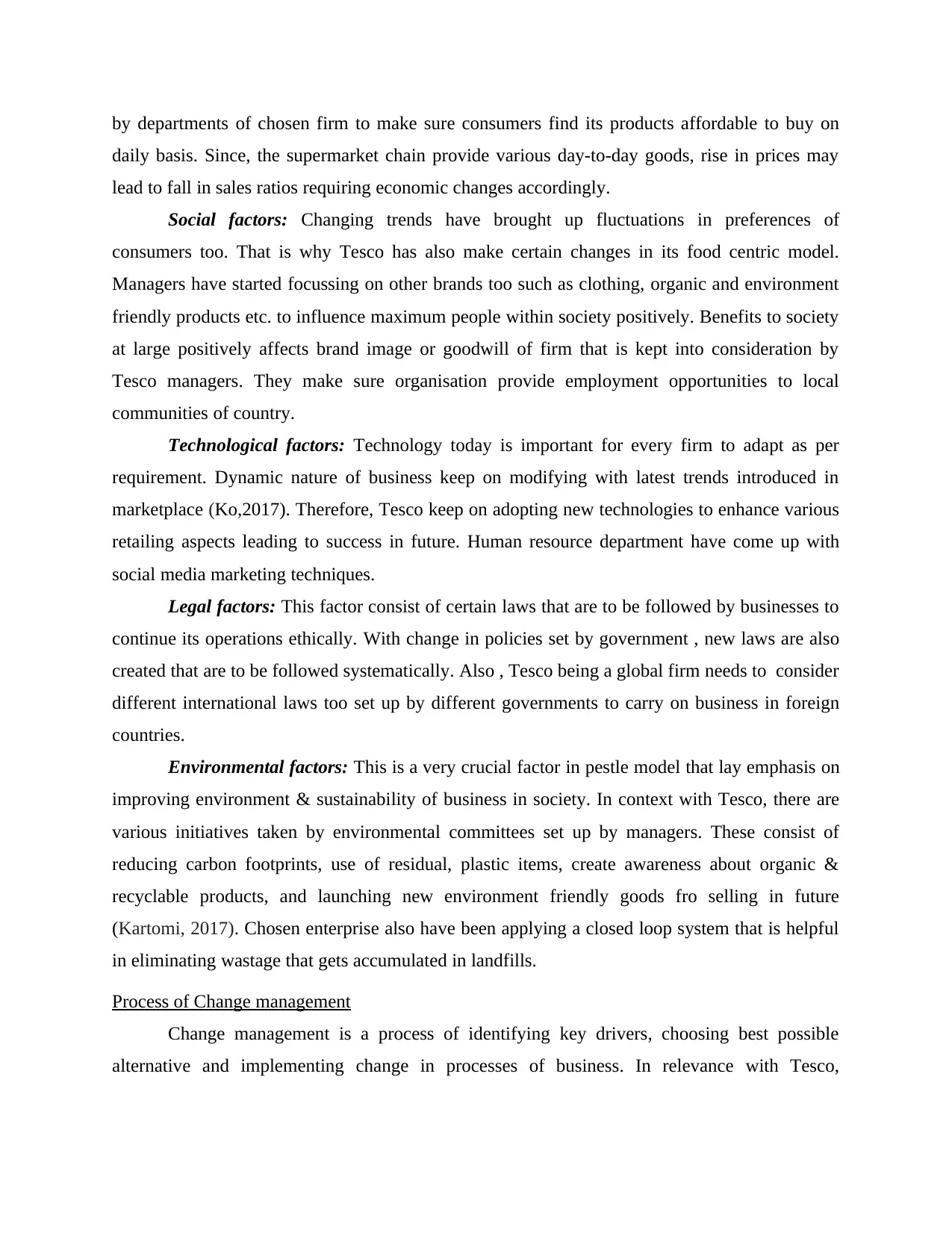
by departments of chosen firm to make sure consumers find its products affordable to buy on
daily basis. Since, the supermarket chain provide various day-to-day goods, rise in prices may
lead to fall in sales ratios requiring economic changes accordingly.
Social factors: Changing trends have brought up fluctuations in preferences of
consumers too. That is why Tesco has also make certain changes in its food centric model.
Managers have started focussing on other brands too such as clothing, organic and environment
friendly products etc. to influence maximum people within society positively. Benefits to society
at large positively affects brand image or goodwill of firm that is kept into consideration by
Tesco managers. They make sure organisation provide employment opportunities to local
communities of country.
Technological factors: Technology today is important for every firm to adapt as per
requirement. Dynamic nature of business keep on modifying with latest trends introduced in
marketplace (Ko,2017). Therefore, Tesco keep on adopting new technologies to enhance various
retailing aspects leading to success in future. Human resource department have come up with
social media marketing techniques.
Legal factors: This factor consist of certain laws that are to be followed by businesses to
continue its operations ethically. With change in policies set by government , new laws are also
created that are to be followed systematically. Also , Tesco being a global firm needs to consider
different international laws too set up by different governments to carry on business in foreign
countries.
Environmental factors: This is a very crucial factor in pestle model that lay emphasis on
improving environment & sustainability of business in society. In context with Tesco, there are
various initiatives taken by environmental committees set up by managers. These consist of
reducing carbon footprints, use of residual, plastic items, create awareness about organic &
recyclable products, and launching new environment friendly goods fro selling in future
(Kartomi, 2017). Chosen enterprise also have been applying a closed loop system that is helpful
in eliminating wastage that gets accumulated in landfills.
Process of Change management
Change management is a process of identifying key drivers, choosing best possible
alternative and implementing change in processes of business. In relevance with Tesco,
daily basis. Since, the supermarket chain provide various day-to-day goods, rise in prices may
lead to fall in sales ratios requiring economic changes accordingly.
Social factors: Changing trends have brought up fluctuations in preferences of
consumers too. That is why Tesco has also make certain changes in its food centric model.
Managers have started focussing on other brands too such as clothing, organic and environment
friendly products etc. to influence maximum people within society positively. Benefits to society
at large positively affects brand image or goodwill of firm that is kept into consideration by
Tesco managers. They make sure organisation provide employment opportunities to local
communities of country.
Technological factors: Technology today is important for every firm to adapt as per
requirement. Dynamic nature of business keep on modifying with latest trends introduced in
marketplace (Ko,2017). Therefore, Tesco keep on adopting new technologies to enhance various
retailing aspects leading to success in future. Human resource department have come up with
social media marketing techniques.
Legal factors: This factor consist of certain laws that are to be followed by businesses to
continue its operations ethically. With change in policies set by government , new laws are also
created that are to be followed systematically. Also , Tesco being a global firm needs to consider
different international laws too set up by different governments to carry on business in foreign
countries.
Environmental factors: This is a very crucial factor in pestle model that lay emphasis on
improving environment & sustainability of business in society. In context with Tesco, there are
various initiatives taken by environmental committees set up by managers. These consist of
reducing carbon footprints, use of residual, plastic items, create awareness about organic &
recyclable products, and launching new environment friendly goods fro selling in future
(Kartomi, 2017). Chosen enterprise also have been applying a closed loop system that is helpful
in eliminating wastage that gets accumulated in landfills.
Process of Change management
Change management is a process of identifying key drivers, choosing best possible
alternative and implementing change in processes of business. In relevance with Tesco,
Paraphrase This Document
Need a fresh take? Get an instant paraphrase of this document with our AI Paraphraser
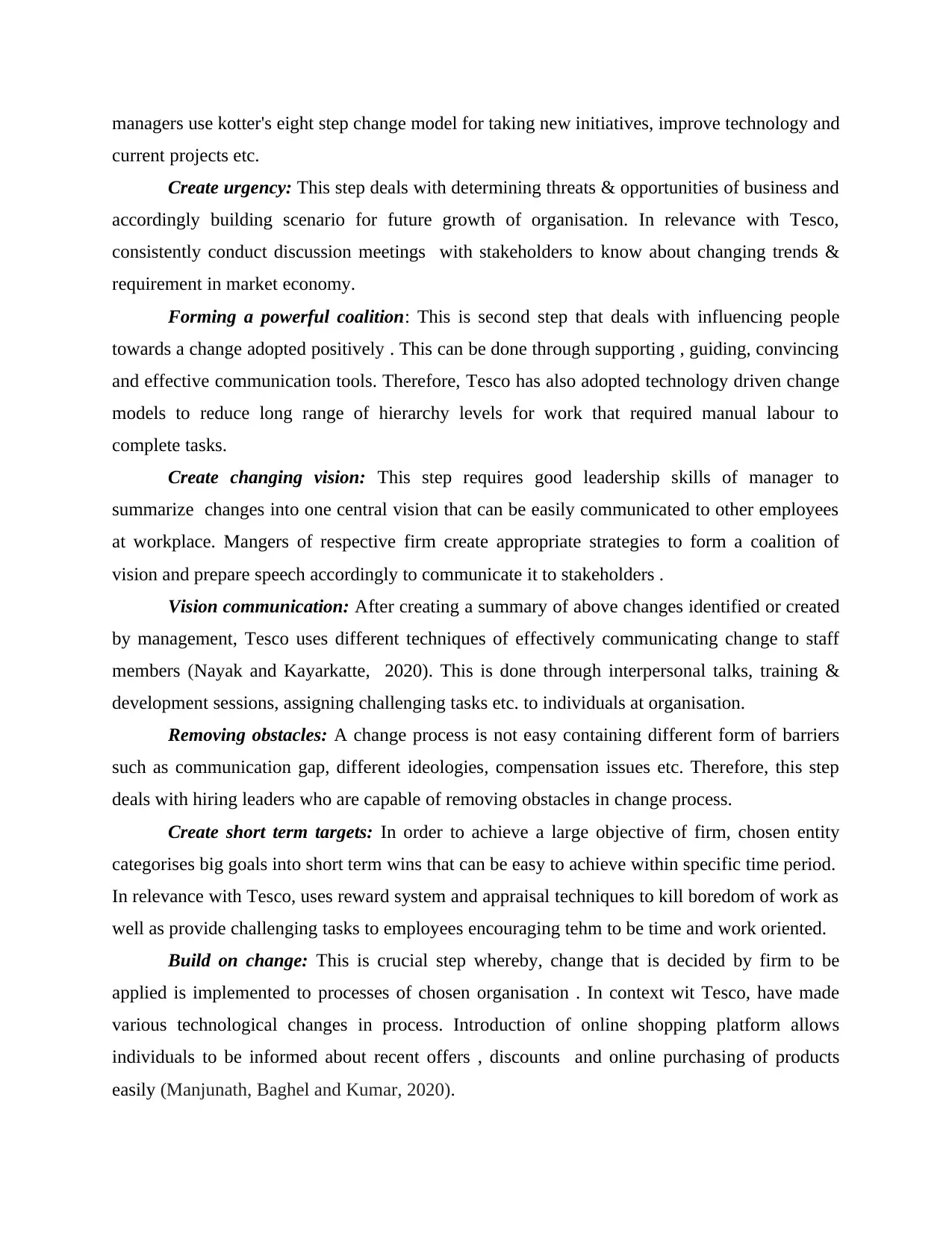
managers use kotter's eight step change model for taking new initiatives, improve technology and
current projects etc.
Create urgency: This step deals with determining threats & opportunities of business and
accordingly building scenario for future growth of organisation. In relevance with Tesco,
consistently conduct discussion meetings with stakeholders to know about changing trends &
requirement in market economy.
Forming a powerful coalition: This is second step that deals with influencing people
towards a change adopted positively . This can be done through supporting , guiding, convincing
and effective communication tools. Therefore, Tesco has also adopted technology driven change
models to reduce long range of hierarchy levels for work that required manual labour to
complete tasks.
Create changing vision: This step requires good leadership skills of manager to
summarize changes into one central vision that can be easily communicated to other employees
at workplace. Mangers of respective firm create appropriate strategies to form a coalition of
vision and prepare speech accordingly to communicate it to stakeholders .
Vision communication: After creating a summary of above changes identified or created
by management, Tesco uses different techniques of effectively communicating change to staff
members (Nayak and Kayarkatte, 2020). This is done through interpersonal talks, training &
development sessions, assigning challenging tasks etc. to individuals at organisation.
Removing obstacles: A change process is not easy containing different form of barriers
such as communication gap, different ideologies, compensation issues etc. Therefore, this step
deals with hiring leaders who are capable of removing obstacles in change process.
Create short term targets: In order to achieve a large objective of firm, chosen entity
categorises big goals into short term wins that can be easy to achieve within specific time period.
In relevance with Tesco, uses reward system and appraisal techniques to kill boredom of work as
well as provide challenging tasks to employees encouraging tehm to be time and work oriented.
Build on change: This is crucial step whereby, change that is decided by firm to be
applied is implemented to processes of chosen organisation . In context wit Tesco, have made
various technological changes in process. Introduction of online shopping platform allows
individuals to be informed about recent offers , discounts and online purchasing of products
easily (Manjunath, Baghel and Kumar, 2020).
current projects etc.
Create urgency: This step deals with determining threats & opportunities of business and
accordingly building scenario for future growth of organisation. In relevance with Tesco,
consistently conduct discussion meetings with stakeholders to know about changing trends &
requirement in market economy.
Forming a powerful coalition: This is second step that deals with influencing people
towards a change adopted positively . This can be done through supporting , guiding, convincing
and effective communication tools. Therefore, Tesco has also adopted technology driven change
models to reduce long range of hierarchy levels for work that required manual labour to
complete tasks.
Create changing vision: This step requires good leadership skills of manager to
summarize changes into one central vision that can be easily communicated to other employees
at workplace. Mangers of respective firm create appropriate strategies to form a coalition of
vision and prepare speech accordingly to communicate it to stakeholders .
Vision communication: After creating a summary of above changes identified or created
by management, Tesco uses different techniques of effectively communicating change to staff
members (Nayak and Kayarkatte, 2020). This is done through interpersonal talks, training &
development sessions, assigning challenging tasks etc. to individuals at organisation.
Removing obstacles: A change process is not easy containing different form of barriers
such as communication gap, different ideologies, compensation issues etc. Therefore, this step
deals with hiring leaders who are capable of removing obstacles in change process.
Create short term targets: In order to achieve a large objective of firm, chosen entity
categorises big goals into short term wins that can be easy to achieve within specific time period.
In relevance with Tesco, uses reward system and appraisal techniques to kill boredom of work as
well as provide challenging tasks to employees encouraging tehm to be time and work oriented.
Build on change: This is crucial step whereby, change that is decided by firm to be
applied is implemented to processes of chosen organisation . In context wit Tesco, have made
various technological changes in process. Introduction of online shopping platform allows
individuals to be informed about recent offers , discounts and online purchasing of products
easily (Manjunath, Baghel and Kumar, 2020).
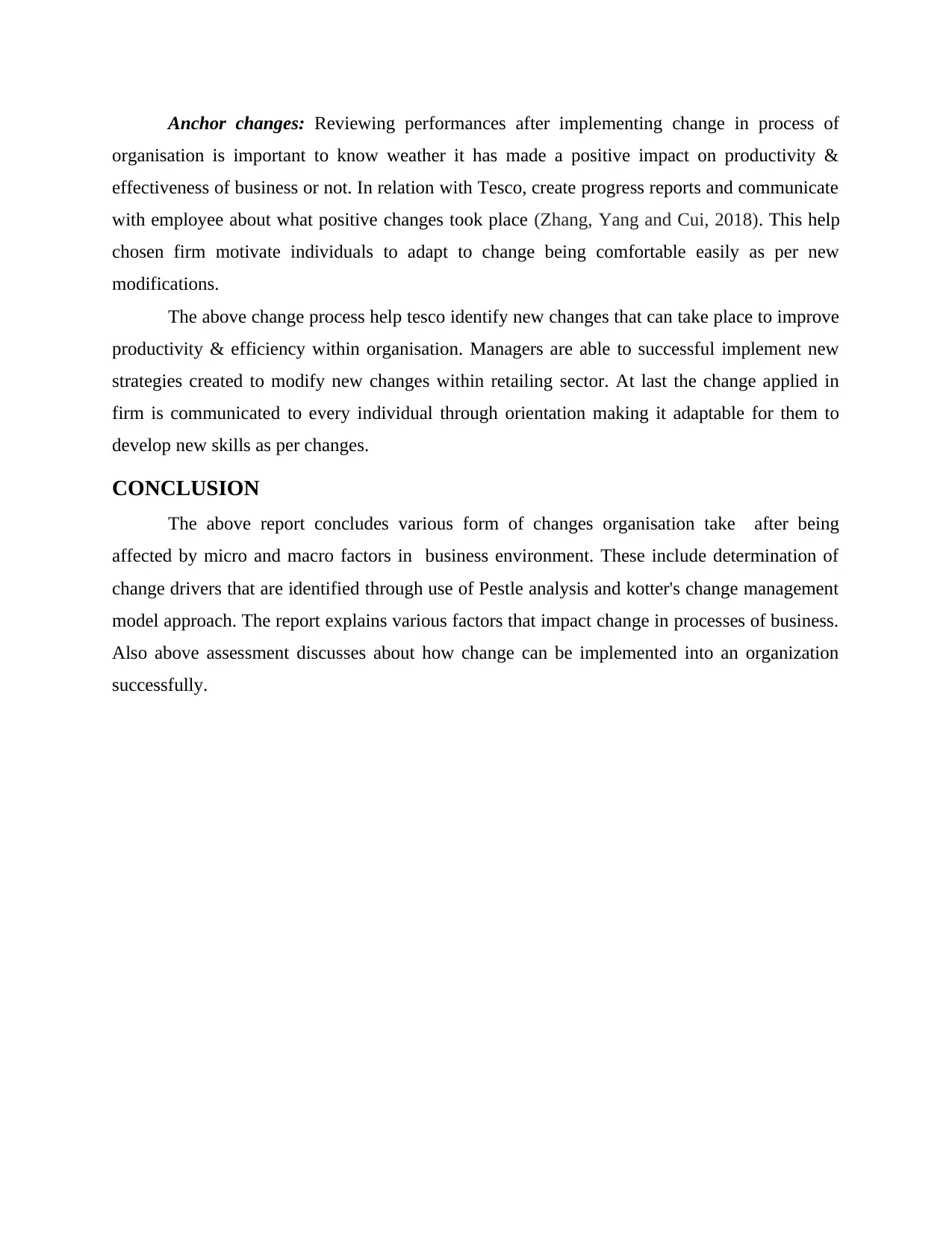
Anchor changes: Reviewing performances after implementing change in process of
organisation is important to know weather it has made a positive impact on productivity &
effectiveness of business or not. In relation with Tesco, create progress reports and communicate
with employee about what positive changes took place (Zhang, Yang and Cui, 2018). This help
chosen firm motivate individuals to adapt to change being comfortable easily as per new
modifications.
The above change process help tesco identify new changes that can take place to improve
productivity & efficiency within organisation. Managers are able to successful implement new
strategies created to modify new changes within retailing sector. At last the change applied in
firm is communicated to every individual through orientation making it adaptable for them to
develop new skills as per changes.
CONCLUSION
The above report concludes various form of changes organisation take after being
affected by micro and macro factors in business environment. These include determination of
change drivers that are identified through use of Pestle analysis and kotter's change management
model approach. The report explains various factors that impact change in processes of business.
Also above assessment discusses about how change can be implemented into an organization
successfully.
organisation is important to know weather it has made a positive impact on productivity &
effectiveness of business or not. In relation with Tesco, create progress reports and communicate
with employee about what positive changes took place (Zhang, Yang and Cui, 2018). This help
chosen firm motivate individuals to adapt to change being comfortable easily as per new
modifications.
The above change process help tesco identify new changes that can take place to improve
productivity & efficiency within organisation. Managers are able to successful implement new
strategies created to modify new changes within retailing sector. At last the change applied in
firm is communicated to every individual through orientation making it adaptable for them to
develop new skills as per changes.
CONCLUSION
The above report concludes various form of changes organisation take after being
affected by micro and macro factors in business environment. These include determination of
change drivers that are identified through use of Pestle analysis and kotter's change management
model approach. The report explains various factors that impact change in processes of business.
Also above assessment discusses about how change can be implemented into an organization
successfully.
⊘ This is a preview!⊘
Do you want full access?
Subscribe today to unlock all pages.

Trusted by 1+ million students worldwide
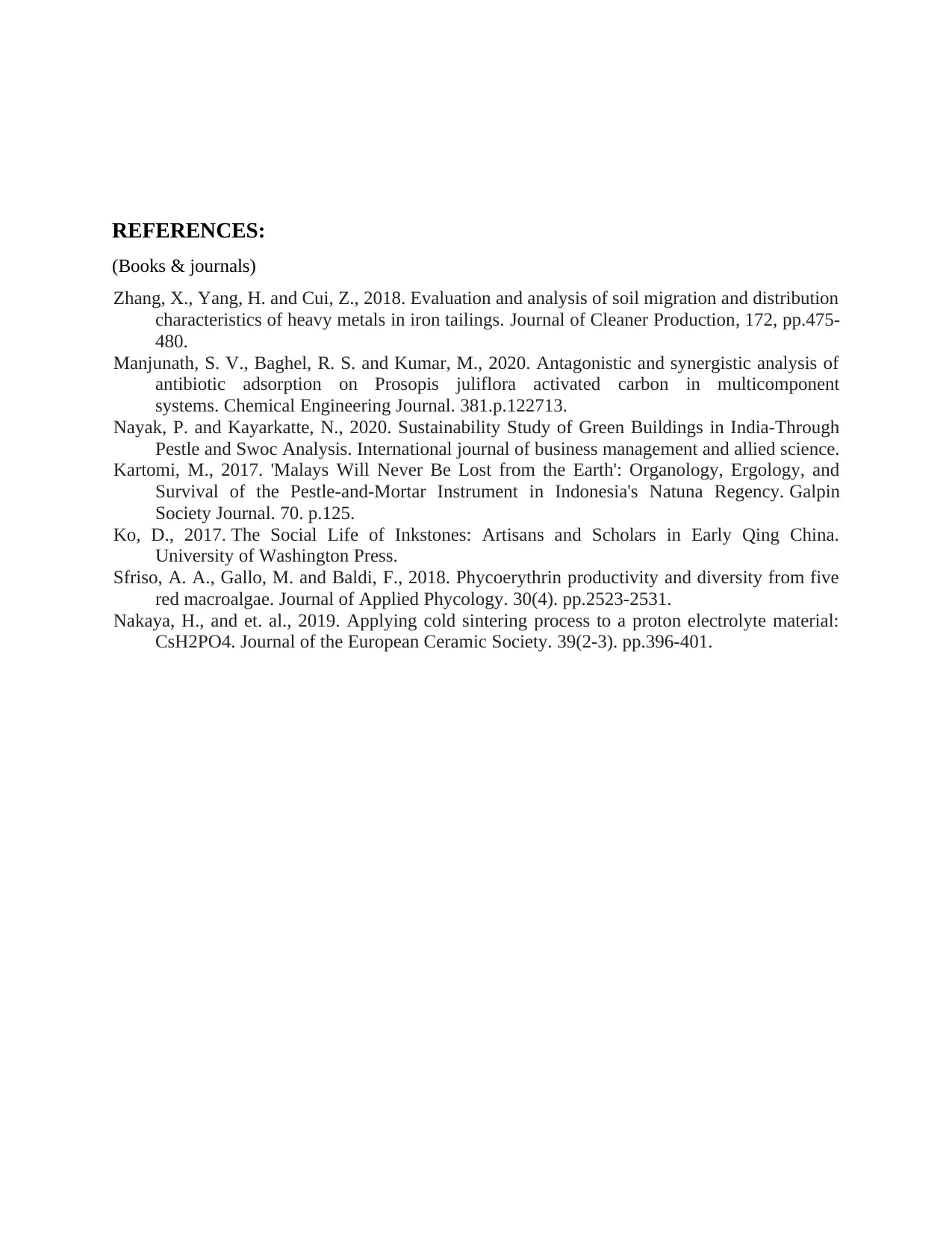
REFERENCES:
(Books & journals)
Zhang, X., Yang, H. and Cui, Z., 2018. Evaluation and analysis of soil migration and distribution
characteristics of heavy metals in iron tailings. Journal of Cleaner Production, 172, pp.475-
480.
Manjunath, S. V., Baghel, R. S. and Kumar, M., 2020. Antagonistic and synergistic analysis of
antibiotic adsorption on Prosopis juliflora activated carbon in multicomponent
systems. Chemical Engineering Journal. 381.p.122713.
Nayak, P. and Kayarkatte, N., 2020. Sustainability Study of Green Buildings in India-Through
Pestle and Swoc Analysis. International journal of business management and allied science.
Kartomi, M., 2017. 'Malays Will Never Be Lost from the Earth': Organology, Ergology, and
Survival of the Pestle-and-Mortar Instrument in Indonesia's Natuna Regency. Galpin
Society Journal. 70. p.125.
Ko, D., 2017. The Social Life of Inkstones: Artisans and Scholars in Early Qing China.
University of Washington Press.
Sfriso, A. A., Gallo, M. and Baldi, F., 2018. Phycoerythrin productivity and diversity from five
red macroalgae. Journal of Applied Phycology. 30(4). pp.2523-2531.
Nakaya, H., and et. al., 2019. Applying cold sintering process to a proton electrolyte material:
CsH2PO4. Journal of the European Ceramic Society. 39(2-3). pp.396-401.
(Books & journals)
Zhang, X., Yang, H. and Cui, Z., 2018. Evaluation and analysis of soil migration and distribution
characteristics of heavy metals in iron tailings. Journal of Cleaner Production, 172, pp.475-
480.
Manjunath, S. V., Baghel, R. S. and Kumar, M., 2020. Antagonistic and synergistic analysis of
antibiotic adsorption on Prosopis juliflora activated carbon in multicomponent
systems. Chemical Engineering Journal. 381.p.122713.
Nayak, P. and Kayarkatte, N., 2020. Sustainability Study of Green Buildings in India-Through
Pestle and Swoc Analysis. International journal of business management and allied science.
Kartomi, M., 2017. 'Malays Will Never Be Lost from the Earth': Organology, Ergology, and
Survival of the Pestle-and-Mortar Instrument in Indonesia's Natuna Regency. Galpin
Society Journal. 70. p.125.
Ko, D., 2017. The Social Life of Inkstones: Artisans and Scholars in Early Qing China.
University of Washington Press.
Sfriso, A. A., Gallo, M. and Baldi, F., 2018. Phycoerythrin productivity and diversity from five
red macroalgae. Journal of Applied Phycology. 30(4). pp.2523-2531.
Nakaya, H., and et. al., 2019. Applying cold sintering process to a proton electrolyte material:
CsH2PO4. Journal of the European Ceramic Society. 39(2-3). pp.396-401.
1 out of 7
Related Documents
Your All-in-One AI-Powered Toolkit for Academic Success.
+13062052269
info@desklib.com
Available 24*7 on WhatsApp / Email
![[object Object]](/_next/static/media/star-bottom.7253800d.svg)
Unlock your academic potential
Copyright © 2020–2025 A2Z Services. All Rights Reserved. Developed and managed by ZUCOL.




